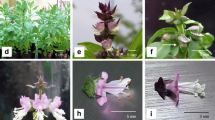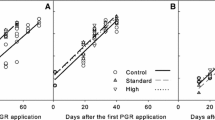Abstract
We developed an efficient method for inducing high-frequency in vitro flowering and fruiting in 10 cultivars (Cap-1 to -10) of three different species of Capsicum (C. annuum, C. chinense, and C. frutescens) collected from diverse geographical regions of India and Mexico. Shoot tips of in vitro germinated seedlings were cultured on MS media supplemented with different concentrations of 6-benzylaminopurine (BAP) alone or in combination with silver nitrate or silver thiosulphate. Low BAP concentration was a good inducer of flower buds in vitro. Synergism between silver ions and cytokinin improved flower induction. Flowering frequency improved significantly when silver nitrate or silver thiosulphate was supplemented with optimum BAP. Maximum responses, 7.5 ± 0.20 (in Cap-1) to 15.8 ± 0.27 (in Cap-5) flowers, were induced in the medium containing 0.75 mg l−1 BAP and 30 μM silver thiosulphate within 60 days of culture. Both in vitro hand-pollination and high sucrose concentration (5.0–6.0 %) in the medium improved fruit setting. In general, fruits were very small (mini-fruit) and seedless; however, three cultivars (Cap-3, -5, and -6) produced normal fruits with seeds. On an average, 144 days were required from seed implantation to fruit ripening. The frequency of meiotic abnormalities was higher in flowers produced in vitro than in those produced in vivo, and pollen viability was relatively lower in the in vitro flowers than in the in vivo flowers. The present protocol offers a repeatable system for studying the physiological mechanism of flowering and fruiting as well as providing the basis for further investigation for rapid in vitro cross-breeding programmes in Capsicum spp. for commercial hybrid production.







Similar content being viewed by others
References
Aloni B, Karni L, Rylski I (1995) Inhibition of heat induced pepper (Capsicum annuum) flower abscission and induction of fruit malformation by silver thiosulphate. J Hortic Sci 70:215–220. doi:10.1080/14620316.1995.11515290
Bais HP, Sudha GS, Ravishankar GA (2000) Putrescine and AgNO3 influences shoot multiplication, in vitro flowering and endogenous titers of polyamines in Cichorium intybus L. cv. Lucknow local. J Plant Growth Regul 19:238–248. doi:10.1007/s003440000012
Bakshi A, Shemansky JM, Chang C, Binder BM (2015) History of research on the plant hormone ethylene. J Plant Growth Regul 34:809–827. doi:10.1007/s00344-015-9522-9
Beyer EM (1976) A potent inhibitor of ethylene action in plants. Plant Physiol 58:268–271
Bodhipadma K, Leung DWM (2003) In vitro fruiting and seed set of Capsicum annuum l. cv. Sweet Banana. In Vitro Cell Dev Biol-Plant 39:536–539. doi:10.1079/IVP2003441
da Silva JAT, Kerbauy GB, Zeng S, Chen Z, Duan J (2014) In vitro flowering of orchids. Crit Rev Biotechnol 34(1):56–76. doi:10.3109/07388551.2013.807219
Das A, Kundu S, Ghosh B (2015) A simple and efficient method for extraction and quantification of capsaicin from pepper fruits through high performance thin layer chromatography. RJPBCS 6(1):606–612. http://www.rjpbcs.com/pdf/2015_6(1)/[73].pdf
De Jeu MJ (2000) In vitro techniques for ornamental breeding. Acta Hortic 508(508):55–60. doi:10.17660/ActaHortic.2000.508.6
Franklin G, Pius PK, Ignacimuthu S (2000) Factors affecting in vitro flowering and fruiting of green pea (Pisum sativum L.). Euphytica 115:65–73. doi:10.1023/A:1003982900117
Haque SM, Ghosh B (2013a) High frequency microcloning of Aloe vera and their true-to-type conformity by molecular cytogenetic assessment of two years old field growing regenerated plants. Bot Stud 54:46. http://www.as-botanicalstudies.com/content/54/1/46
Haque SM, Ghosh B (2013b) In vitro completion of sexual life cycle: production of R1 plants of Ipomoea quamoclit L. Propag Ornam Plants 13:19–24. http://www.journal-pop.org/2013_13_1_19-24.html
Haque SM, Ghosh B (2013c) Micropropagation, in vitro flowering and cytological studies of Bacopa chamaedryoides, an ethno-medicinal plant. Environ Exp Biol 11:59–68. http://eeb.lu.lv/EEB/201303/EEB_11_Haque.pdf
Haque SM, Ghosh B (2016a) Cytological studies of sporophytic and gametophytic generation of two bulbaceous species Ledebouria revoluta and Drimiopsis botryoides (Asparagaceae). Caryologia 69:38–49. doi:10.1080/00087114.2015.1109940
Haque SM, Ghosh B (2016b) Cell division study in ‘pollen mother cells’ and ‘pollen grains’ of in vivo and ex vitro plants in Drimiopsis botryoides. Grana. doi:10.1080/00173134.2016.1144785
Haque SM, Ghosh B (2016c) High-frequency somatic embryogenesis and artificial seeds for mass production of true-to-type plants in Ledebouria revoluta: an important cardioprotective plant. Plant Cell Tissue Organ Cult. doi:10.1007/s11240-016-1030-5
Hoyer L (1998) Silver thiosulphate can considerably reduce leaf and fruit abscission caused by ethylene in Capsicum annuum ‘Janne’. J Hortic Sci Biotechnol 73:29–34. doi:10.1080/14620316.1998.11510939
Jeong BR, Sivanesan I (2015) Direct adventitious shoot regeneration, in vitro flowering, fruiting, secondary metabolite content and antioxidant activity of Scrophularia takesimensis Nakai. Plant Cell Tissue Organ Cult 123:607–618. doi:10.1007/s11240-015-0864-6
Joshi M, Nadgauda RS (1997) Cytokinins and in vitro induction of flowering in bamboo: Bambusa arundinacea (Retz.) Willd. Curr Sci 73:523–526
Kamvorn W, Techawongstien S, Techawongstien S, Theerakulpisut P (2014) Compatibility of inter-specific crosses between Capsicum chinense Jacq. and Capsicum baccatum L. at different fertilization stages. Sci Hortic 179:9–15. doi:10.1016/j.scienta.2014.09.003
Kaur D, Dogra V, Thapa P, Bhattacharya A, Sood A (2015) In vitro flowering associated protein changes in Dendrocalamus hamiltonii. Proteomics 15:1291–1306. doi:10.1002/pmic.201400049
Kehie M, Kumaria S, Tandon P (2012) In vitro plantlet regeneration from nodal segments and shoot tips of Capsicum chinense Jacq. cv. Naga King Chili. 3. Biotech 2:31–35. doi:10.1007/s13205-011-0025-5
Kothari SL, Joshi A, Kachhwaha S, Ochoa-Alejo N (2010) Chilli peppers: a review on tissue culture and transgenesis. Biotechnol Adv 28:35–48. doi:10.1016/j.biotechadv.2009.08.005
Kumar V, Parvatam G, Ravishankar GA (2009) AgNO3 - a potential regulator of ethylene activity and plant growth modulator. Electron J Biotechnol 12:2. doi:10.2225/vol12-issue2-fulltext-1
Kundu S, Das A, Ghosh B (2015a) Modulation of pungency and major bioactive compounds in pepper due to agro-climatic discrepancy: a case study with Capsicum chinense Bhut Jolokia fruit. Int J Pharm Pharm Sci 7:294–298
Kundu S, Das A, Haque SM, Ghosh B (2015b) Chemotypic diversity in different Bhut Jolokia fruits: in vitro conservation and mass propagation of superior ecotype. Int J Pharm Sci Rev Res 34(2):47–53
Manzur JP, Fita A, Prohens J, Rodríguez-Burruezo A (2015) Successful wide hybridization and introgression breeding in a diverse set of common peppers (Capsicum annuum) using different cultivated Ají (C. baccatum) accessions as donor parents. PLoS One. doi:10.1371/journal.pone.0144142
Máthé Á, Hassan F, Kader AA (2015) In vitro micropropagation of medicinal and aromatic plants. In: Máthé Á (ed) Medicinal and aromatic plants of the world. Springer, Berlin. doi:10.1007/978-94-017-9810-5_15
Murashige T, Skoog F (1962) A revised medium for rapid growth and bioassays with tobacco tissue cultures. Physiol Plant 15:473–497. doi:10.1111/j.1399-3054.1962.tb08052.x
Murthy KSR, Kondamudi R, Rao PVC, Pullaiah T (2012) In vitro flowering: a review. J Agric Technol. 8(5):1517–1536. http://www.ijat-aatsea.com/pdf/v8_n5_12_July/01_IJAT_2012_8(5)
Ochoa-Alejo N, Ramirez-Malagon R (2001) In vitro chili pepper biotechnology. In Vitro Cell Dev Biol-Plant 37:701–729
Paul S, Das A, Sarkar NC, Ghosh B (2013) Collection of chilli genetic resources from different geographical regions of West Bengal, India. Int J Bioresour Stress Manag 4:147–153. http://www.indianjournals.com/ijor.aspx?target=ijor:ijbsm&volume=4&issue=2&article=007
Ramchiary N, Kehie M, Brahma V, Kumaria S, Tandon P (2014) Application of genetics and genomics towards Capsicum translational research. Plant Biotechnol Rep 8:101–123. doi:10.1007/s11816-013-0306-z
Ribalta FM, Croser JS, Erskine W, Finnegan PM, Lulsdorf MM, Ochatt SJ (2014) Antigibberellin-induced reduction of internode length favors in vitro flowering and seed-set in different pea genotypes. Biol Plant 58(1):39–46. doi:10.1007/s10535-013-0379-0
Sarker RH, Das SK, Hoque MI (2012) In vitro flowering and seed formation in lentil (Lens culinaris Medik.). In Vitro Cell Dev Biol-Plant 48:446–452. doi:10.1007/s11627-012-9444-1
Sharma A, Kumar V, Giridhar P, Ravishankar GA (2008) Induction of in vitro flowering in Capsicum frutescens under the influence of silver nitrate and cobalt chloride and pollen transformation. Electron J Biotechnol 11:2. doi:10.2225/vol11-issue2-fulltext-8
Sheeja TE, Mandal AB (2003) In vitro flowering and fruiting in tomato (Lycopersicon esculentum Mill.). Asia Pac J Mol Biol Biotechnol 11(1):37–42. http://www.msmbb.org.my/apjmbb/html111/pg37.pdf
Sim GE, Loh CS, Goh CJ (2007) High frequency early in vitro flowering of Dendrobium Madame Thong-In (Orchidaceae). Plant Cell Rep 26:383–393. doi:10.1007/s00299-006-0242-2
Sivanandan G, Theboral J, Dev GK, Selvaraj N, Manickavasagam M, Ganarathi A (2015) Effect of carbon and nitrogen sources on in vitro flower and fruit formation and withanolides production in Withania somnifera (L.) Dunal. Indian J Exp Biol 53:177–183. http://www.ncbi.nlm.nih.gov/pubmed/25872249
Sivanesan I, Park SW (2015) Optimizing factors affecting adventitious shoot regeneration, in vitro flowering and fruiting of Withania somnifera (L.) Dunal. Ind Crop Prod 76:223–328. doi:10.1016/j.indcrop.2015.05.014
Taylor NJ, Light ME, Staden JV (2005) In vitro flowering of Kniphofia leucocephala: influence of cytokinins. Plant Cell Tissue Organ Cult 83:327–333. doi:10.1007/s11240-005-8429-8
Thul ST, Lal RK, Shasany AK, Darokar MP, Gupta MM, Verma RK, Khanuja SPS (2009) Estimation of phenotypic divergence in a collection of Capsicum species for yield-related traits. Euphytica 168:189–196. doi:10.1007/s10681-009-9882-y
Tisserat B, Galletta PD (1995) In vitro flowering and fruiting of Capsicum fruitescens L. HortScience 30(1):130–132. http://hortsci.ashspublications.org/content/30/1/130.full.pdf+html
Todorović SD, Grubišić DZ, Giba ZD, Mišić Konjević R (2006) Sucrose effects on in vitro fruiting and seed production of Centaurium pulchellum. Biol Plant 50(4):771–774. doi:10.1007/s10535-006-0128-8
Tomiczak K, Mikuła A, Sliwinska E, Rybczyński JJ (2015) Autotetraploid plant regeneration by indirect somatic embryogenesis from leaf mesophyll protoplasts of diploid Gentiana decumbens L.f. In Vitro Cell Dev Biol-Plant 51:350–359. doi:10.1007/s11627-015-9674-0
Wang S, Tang L, Chen F (2001) In vitro flowering of bitter melon. Plant Cell Rep 20:393–397. doi:10.1007/s002990100351
Würschum T (2015) Ethylene inhibitors improve efficiency of microspore embryogenesis in hexaploid triticale. Plant Cell Tissue Organ Cult 122:751–757. doi:10.1007/s11240-015-0808-1
Zhang T (2007) In vitro flowering of Perilla frutescens. In Vitro Cell Dev Biol-Plant 43:91–94. doi:10.1007/s11627-007-9038-5
Acknowledgments
SMH acknowledges the Ministry of Minority Affairs (MOMA) and the University Grant Commission (UGC) of India for providing Maulana Azad National Fellowship (MANF). BG thanks the Department of Science and Technology, West Bengal (DST-WB) for providing a research Grant. All authors acknowledge Dr. Paul W. Bosland, Professor of the Department of Agronomy and Horticulture, New Mexico State University, Mexico for gifting us the seeds of Mexican cultivars of Capsicum, and Swami Kamalasthananda, Principal, Ramakrishna Mission Vivekananda Centenary College, Rahara, Kolkata, India for the facilities provided during the present study. The DST-FIST programme for infrastructural facilities is also acknowledged.
Authors’ contribution
SMH carried out all the experimental works and statistical analysis under the guidance of BG. SP help to SMH during experimental work. The manuscript was initially drafted by SMH and critically revised by BG, then finally checked and approved by all authors. BG obtained a research grant [Grant Number 616(Sanc.)/ST/P/S&T/1G-6/2011] for conducting the work.
Author information
Authors and Affiliations
Corresponding author
Ethics declarations
Conflict of interest
The authors declare that they have no conflict of interest.
Rights and permissions
About this article
Cite this article
Haque, S.M., Paul, S. & Ghosh, B. High-frequency in vitro flowering, hand-pollination and fruit setting in ten different cultivars of Capsicum spp. (C. annuum, C. chinense, and C. frutescens): an initial step towards in vitro hybrid production. Plant Cell Tiss Organ Cult 127, 161–173 (2016). https://doi.org/10.1007/s11240-016-1039-9
Received:
Accepted:
Published:
Issue Date:
DOI: https://doi.org/10.1007/s11240-016-1039-9




